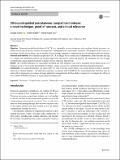Files in this item
Ultrasound-guided percutaneous compartment release : a novel technique, proof of concept, and clinical relevance
Item metadata
| dc.contributor.author | Davies, Joseph | |
| dc.contributor.author | Fallon, Valerie | |
| dc.contributor.author | Kyaw Tun, Jimmy | |
| dc.date.accessioned | 2019-06-26T15:30:06Z | |
| dc.date.available | 2019-06-26T15:30:06Z | |
| dc.date.issued | 2019-06 | |
| dc.identifier | 259383354 | |
| dc.identifier | b9af8781-de7d-4245-9cbb-775282d28763 | |
| dc.identifier | 85058934068 | |
| dc.identifier.citation | Davies , J , Fallon , V & Kyaw Tun , J 2019 , ' Ultrasound-guided percutaneous compartment release : a novel technique, proof of concept, and clinical relevance ' , Skeletal Radiology , vol. 48 , no. 6 , pp. 959-963 . https://doi.org/10.1007/s00256-018-3134-y | en |
| dc.identifier.issn | 0364-2348 | |
| dc.identifier.uri | https://hdl.handle.net/10023/17974 | |
| dc.description.abstract | Objective Ultrasound-guided thread release (USGTR) is a minimally invasive technique with excellent clinical outcomes currently used in clinical practice to divide the transverse carpal ligament in carpal tunnel syndrome. The purpose of this study is to determine whether this technique can be modified for use in large anatomical compartments in soft embalmed cadaveric models. Materials and methods Two operators adapted the USGTR technique for use in muscular compartments of the forearms and legs in a single soft embalmed cadaver. An iterative approach was used to adapt and improve the technique for use in large compartments, using equipment readily available in most radiology departments. Results The USGTR technique was successfully modified and both operators were able to accurately divide fascial layers over distances of up to 30 cm using the modified technique. Fascial division was confirmed with ultrasound and dissection. Conclusions This adapted technique can successfully be used to divide fascial planes over longer distances than is currently achieved in clinical practice. The improved outcomes associated with USGTR at the carpal tunnel may therefore also be achievable in fasciotomy procedures in larger anatomical compartments. Further study is required to investigate the effects of this modified USGTR technique on intracompartmental pressure. | |
| dc.format.extent | 4 | |
| dc.format.extent | 1463933 | |
| dc.language.iso | eng | |
| dc.relation.ispartof | Skeletal Radiology | en |
| dc.subject | Ultrasound | en |
| dc.subject | Compartment syndrome | en |
| dc.subject | Minimally invasive | en |
| dc.subject | Thread Release | en |
| dc.subject | RC Internal medicine | en |
| dc.subject | NDAS | en |
| dc.subject.lcc | RC | en |
| dc.title | Ultrasound-guided percutaneous compartment release : a novel technique, proof of concept, and clinical relevance | en |
| dc.type | Journal article | en |
| dc.contributor.institution | University of St Andrews. School of Medicine | en |
| dc.identifier.doi | https://doi.org/10.1007/s00256-018-3134-y | |
| dc.description.status | Peer reviewed | en |
This item appears in the following Collection(s)
Items in the St Andrews Research Repository are protected by copyright, with all rights reserved, unless otherwise indicated.

